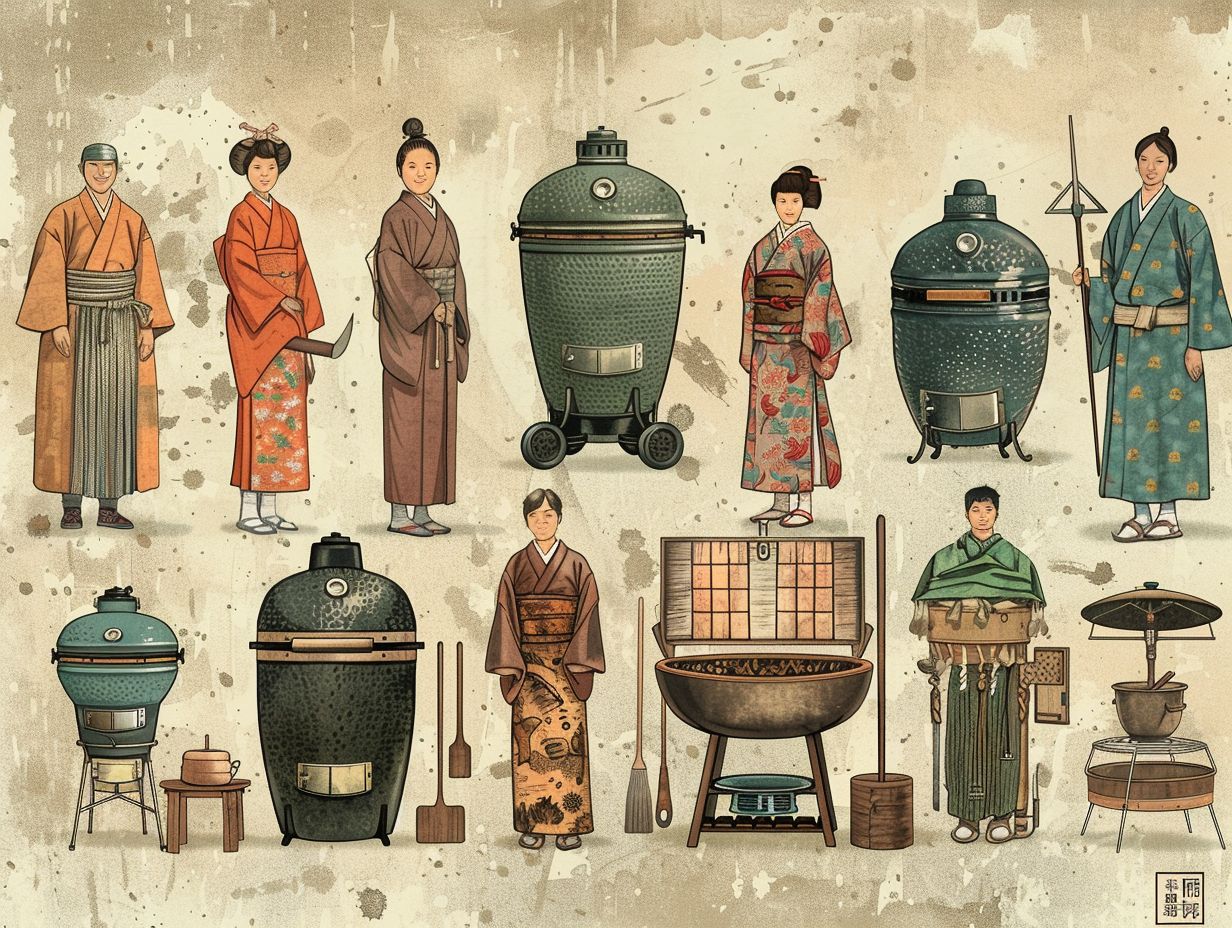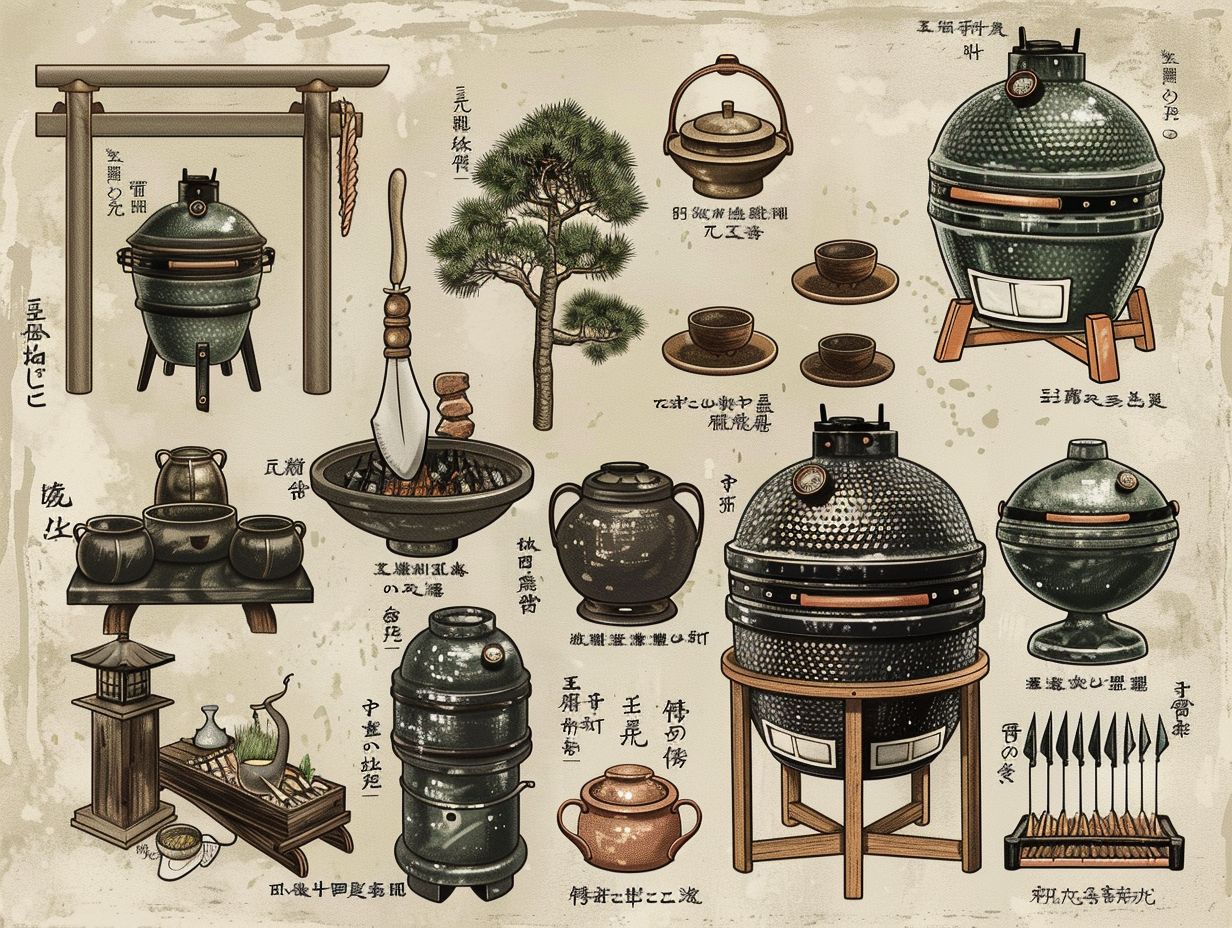Kamado grills have a rich history that dates back to ancient Japan, where they were valued for their distinctive cooking capabilities.
Over the centuries, these versatile cooking devices have evolved and significantly influenced barbecue culture and techniques globally.
This article delves into the origins of kamado grills, highlighting key milestones in their development and identifying what distinguishes them from other grilling methods.
You will uncover the fascinating journey of kamado grills and their impact on modern barbecue cooking.
Key Takeaways:

- Kamado grills have a rich history dating back to ancient Japan, where they were used for cooking and ceremonies.
- Over the centuries, kamado grills have evolved and incorporated new features and technologies, making them a popular choice for modern BBQ enthusiasts.
- The unique design and versatility of kamado grills have had a significant impact on BBQ culture, influencing cooking techniques and flavors around the world.
The Origins of Kamado Grills
The origins of Kamado grills can be traced back to ancient Japan, where they were first developed during the Kofun period. This innovation was influenced by similar cooking devices that originated in China during the Qin dynasty.
Historical Background in Ancient Japan
During the Kofun period in ancient Japan, the development of ceramics led to the creation of the Kamado, a traditional cooking device that plays a vital role in Japanese cuisine.
This earthenware stove, known for its rounded shape and intricate design, utilizes the heat retention properties of clay to achieve precise cooking temperatures, making it ideal for a variety of techniques, from steaming to slow cooking. The craftsmanship involved in creating the Kamado is not only functional but also carries cultural significance, reflecting the artistry and dedication of Japanese potters.
Cooking with this remarkable device fosters family gatherings, infusing meals with flavors that are deeply rooted in the tradition of communal dining. Thus, the Kamado serves not only as a cooking apparatus but also as a symbol of heritage, preserving culinary practices that have transcended generations and continue to influence contemporary Japanese cooking today.
The Evolution of Kamado Grills
The evolution of Kamado grills from their traditional designs to the modern iterations, including the widely recognized Big Green Egg developed by Ed Fisher, demonstrates a remarkable fusion of functionality and style.
Key Milestones in Development

Key milestones in the development of Kamado grills include the introduction of the Big Green Egg, which revolutionized barbecue cooking by popularizing the use of charcoal and advanced ceramic technology.
This innovative approach not only improved the performance and heat retention of traditional clay cookers but also added a new aesthetic appeal to outdoor cooking. As a result, you can see enthusiasts experimenting with various cooking techniques, from low-and-slow smoking to high-heat grilling, leveraging the grill’s versatility to create a wide range of delicious meals.
The rise of these iconic grills has fostered a vibrant community of barbecue aficionados who share tips, participate in cook-offs, and embrace a culture focused on flavor and craftsmanship. This transformation has not only reshaped how people engage with outdoor cooking but has also solidified Kamado grills as a staple in modern backyard barbecues.
What Makes Kamado Grills Unique?
Kamado grills stand out because of their exceptional features, including superior heat retention, effective moisture control, and the ability to infuse rich flavors into a wide range of dishes. These characteristics distinguish them from traditional grills and enhance your cooking experience.
Features and Advantages of Kamado Cooking
The standout features of Kamado cooking include exceptional heat retention, which allows for precise temperature control, and the capability to maintain moisture in meats, making it an ideal choice for barbecue enthusiasts.
This unique design, often constructed from thick ceramic, serves as effective insulation that traps heat, enabling you to achieve high temperatures while conserving charcoal. For example, when preparing dishes like smoked brisket or pulled pork, the Kamado grill retains smoke flavor while ensuring that the meat remains juicy and tender throughout the slow cooking process.
Its versatility extends beyond traditional grilling; it can easily transition to baking pizzas or roasting vegetables, showcasing an adaptability that few other grills can match. This means that whether you are a seasoned chef or a beginner, the Kamado grill promises to enhance your cooking experience.
The Impact of Kamado Grills on BBQ Culture
Kamado grills have played a significant role in shaping BBQ culture by introducing innovative cooking techniques and enhancing the flavors of grilled foods. This appeal resonates with both traditionalists and modern cooks, allowing for a diverse range of culinary experiences.
Influence on Cooking Techniques and Flavors

The influence of Kamado grills on cooking techniques and flavors is significant, as they enable various cooking methods, including smoking, grilling, and baking, all of which enhance the overall taste of dishes.
These versatile cooking appliances create a unique environment that effectively retains heat and moisture, resulting in tantalizing flavors that are difficult to replicate with traditional grills. For example, when you utilize the smoking technique, meats like brisket or ribs absorb aromatic wood smoke, imparting rich, complex flavors. Grilling vegetables or seafood on a Kamado also produces delightful char and depth, elevating dishes such as grilled zucchini or salmon.
Moreover, the ability to bake pizzas and bread in these grills introduces a new dimension of culinary experiences, allowing you to enjoy crispy crusts and perfectly melted cheeses that showcase the grill’s distinct characteristics.
Frequently Asked Questions
What is the history of kamado grills?
The history of kamado grills dates back to ancient Japan, where they were first used for cooking and heating in the 3rd century. The word “kamado” means “stove” or “cooking range” in Japanese, and these grills were traditionally made from clay or ceramic materials.
How have kamado grills evolved over time?
Since their beginnings in Japan, kamado grills have undergone various changes and improvements. In the mid-20th century, American soldiers stationed in Japan brought back kamado grills and introduced them to the Western world. From there, manufacturers began experimenting with different materials and designs, resulting in the modern kamado grill we know today.
What are the benefits of using a kamado grill?

Kamado grills are known for their versatility, as they can be used for grilling, smoking, and even baking. They also have excellent heat retention and distribution, making them efficient and allowing for even cooking. Additionally, their unique design and materials make them sturdy and durable, lasting for many years.
What sets kamado grills apart from other types of grills?
Kamado grills have a distinct egg or dome shape, which allows for better heat circulation and retention. Their ceramic or clay construction also gives them the ability to reach high temperatures, making them ideal for searing and cooking pizza. They also offer a wide temperature range, allowing for both low and slow cooking or high-heat grilling.
How has the popularity of kamado grills grown in recent years?
In recent years, kamado grills have experienced a surge in popularity as more people discover their unique benefits and versatility. They have also gained attention among BBQ enthusiasts due to their ability to produce flavorful and juicy meats. Many top BBQ competition teams also use kamado grills in their cooking.
What are some modern innovations in kamado grill technology?
While traditional kamado grills were made from ceramic or clay, modern versions may use other materials such as stainless steel or cast iron. Some models also feature electric or gas-powered options, making them more convenient for busy cooks. Additionally, many kamado grills now come with advanced temperature control systems for precise and consistent cooking.




















































